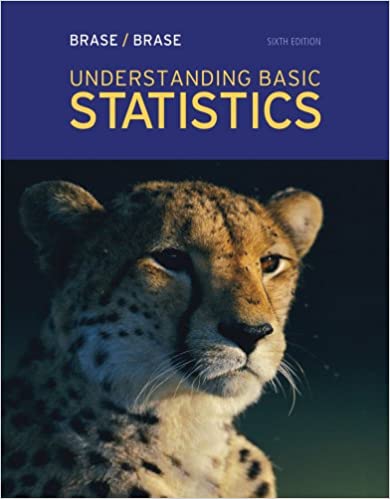
Understanding Basic Statistics 6th Edition by Charles Henry Brase,Corrinne Pellillo Brase
Edition 6ISBN: 978-1111827021
Understanding Basic Statistics 6th Edition by Charles Henry Brase,Corrinne Pellillo Brase
Edition 6ISBN: 978-1111827021 Exercise 23
Provide the following information
(a) What is the level of significance State the null and alternate hypotheses.
(b) Check Requirements What sampling distribution will you use Do you think the sample size is sufficiently large Explain. Compute the value of the sample test statistic.
(c) Find the P -value of the test statistic. Sketch the sampling distribution and show the area corresponding to P -value.
(d) Based on your answer in part (a) to (c), will you reject or fail to reject the null hypothesis Are the data statistically significant at level
(e) Interpret your conclusion in the context of the application.
Focus Problem: Beford's Law Again, suppose you are the auditor for a very large corporation. The revenue file contains millions of numbers in a large computer data bank (see Problem 7). You draw a random sample of n = 228 numbers from this file and r = 92 have a first nonzero digit of 1. Let p represent the population proportion of all numbers in the computer file that have a leading digit of 1.
i. Test the claim that p is less than 0.301. Use = 0.01.
ii. If p is in fact larger than 0.301, it would seem there are too many numbers in the file with leading 1's. Could this indicate that the books have been "cooked" by artificially lowering numbers in the file Comment from the point of view of the Internal Revenue Service. Comment the perspective of the Federal Bureau of Investigation as it looks for "profit skimming" by unscrupulous employees.
iii. Comment on the following statement: "If we reject the null hypothesis at level of significance , we have not proved H 0 to be false. We can say that the probability is that we made a mistake in rejecting H 0." Based on the outcome of the test, would you recommend further investigation before accusing the company of fraud
(a) What is the level of significance State the null and alternate hypotheses.
(b) Check Requirements What sampling distribution will you use Do you think the sample size is sufficiently large Explain. Compute the value of the sample test statistic.
(c) Find the P -value of the test statistic. Sketch the sampling distribution and show the area corresponding to P -value.
(d) Based on your answer in part (a) to (c), will you reject or fail to reject the null hypothesis Are the data statistically significant at level
(e) Interpret your conclusion in the context of the application.
Focus Problem: Beford's Law Again, suppose you are the auditor for a very large corporation. The revenue file contains millions of numbers in a large computer data bank (see Problem 7). You draw a random sample of n = 228 numbers from this file and r = 92 have a first nonzero digit of 1. Let p represent the population proportion of all numbers in the computer file that have a leading digit of 1.
i. Test the claim that p is less than 0.301. Use = 0.01.
ii. If p is in fact larger than 0.301, it would seem there are too many numbers in the file with leading 1's. Could this indicate that the books have been "cooked" by artificially lowering numbers in the file Comment from the point of view of the Internal Revenue Service. Comment the perspective of the Federal Bureau of Investigation as it looks for "profit skimming" by unscrupulous employees.
iii. Comment on the following statement: "If we reject the null hypothesis at level of significance , we have not proved H 0 to be false. We can say that the probability is that we made a mistake in rejecting H 0." Based on the outcome of the test, would you recommend further investigation before accusing the company of fraud
Explanation
(i)- (a)
(i)- (b)
The number of trai...
Understanding Basic Statistics 6th Edition by Charles Henry Brase,Corrinne Pellillo Brase
Why don’t you like this exercise?
Other Minimum 8 character and maximum 255 character
Character 255


